How to Select a Termite
Control Service
For Austin Texas |
|
Retaining
the services of a competent termite control company is important
because termite control requires specialized equipment and knowledge
available only from professionals.
Termites,
which are wood-destroying insects common in most areas of Texas,
cause many millions of dollars of damage annually. Texas has two
major types of termites: subterranean termites, which live in the
soil and are found throughout the state; and drywood termites, which
attack sound, dry wood and are most abundant in coastal areas.
Wooden
structures in Texas have more than a 70 percent chance of being
attacked by termites within 10 to 20 years. Termites may even begin
attacking soon after construction. Properly treating the soil
beneath and around the foundation with termiticidal chemicals before
construction, called a pretreatment, reduces the threat of
subterranean termites. However, because few areas in Texas have
ordinances requiring pretreatments, only a small percentage of
homeowners enjoy such security from termite problems.
Some helpful
Extension publications on this subject, B-6080, “Subterranean
Termites,” L-1782, “Drywood Termites,” and L-5233, “Formosan
Subterranean Termites,” discuss the identification, biology,
behavior and control of these insects.
If you
suspect you have a termite infestation, the following steps will
help you select a termite control service:
•
Don’t panic.
Termites
work slowly, so your house will not collapse or be ruined overnight.
Do not become unduly alarmed if you learn that termites are, or may
be, attacking your home.
•
Take your time.
Do not
permit anyone to rush you into buying termite control services. Take
the time you need to make an informed decision. Delaying a few weeks
makes no difference. There is always time to buy this service wisely
and at your convenience.
Termites may even begin attacking a home soon after construction.

|
Homes are prime targets for termites.
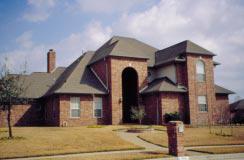
|
Request a termite inspection from at least three companies.
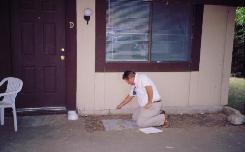
|
(512)454-7336
Order an free estimate online.
Click here
Time is
obviously more pressing if you are trying to sell your home and a real
estate transaction is pending. If the infestation was discovered with
enough time before closing on the transaction, a treatment can still be
chosen and performed to the satisfaction of the buyer, seller and
mortgage company. Closing can also be postponed temporarily until the
treatment is completed, although this is usually not preferred by the
parties concerned.
•
If
you are unsure about whether your home has termites, locate reliable
pest control firms and discuss their termite control services.
Arrange for a
thorough termite inspection, knowing that the costs of inspections,
estimates and terms can vary significantly among companies. Request
inspections from three or more companies. Ask for recommendations from
friends and neighbors; this is one of the best ways to get an honest
opinion about a termite control service.
A proper
inspection should include a written report noting:
•
The location of
areas of active or inactive termite infestations;
•
The location and
number of treatments to be made to control the infestation. A diagram of
the structure should be included, which is extremely helpful in
indicating the location of structural features such as porches, utility
accesses and areas of wood-to-soil contact, as well as areas with
drainage or moisture problems in or near the structure.
•
An estimated
cost of control. Determine whether the estimate is a firm price, and be
cautious if it is not. If you decide to obtain more than one opinion,
quote or inspection, let each firm involved know that other firms were
contacted. As the consumer, you are free to shop, but treat the
companies with the same courtesy and respect you hope they will return
as pest control professionals.
•
Understand the various treatment methods or options.
Consumers
shopping for termite control services have more choices than ever
before. This is good, but it can also be confusing. Options include
baits and soil barriers for subterranean termites, and fumigants and
heat for drywood termites.
Baits versus soil barriers
One of the first
decisions you will have to make is whether to treat using a termite bait
or a conventional soil barrier treatment. Both approaches can be
effective. Soil treatments are used to establish a “barrier” or
“treatment zone” between the wood in the structure and the subterranean
termite colonies in the soil. The chemicals may either kill or repel the
invading termites, but either way the structure is protected if the
applications are thorough. Chemical treatments should last at least 5
years under Texas soil and environmental conditions.
Baiting systems
Several choices
in baiting systems are available from termite control services. Using
baiting systems requires that the applicator have specific knowledge to
apply the baits correctly. It also demands continual monitoring. Some
baiting systems are advertised to be able to stand alone, or be totally
sufficient for termite control; others are used in combination with
liquid termiticides.
In general,
baits require several trips to the job site for installation and
monitoring. Control may take from a few weeks to more than a year.
Soil barriers
For the
sub-slab
method,
holes are drilled in a concrete slab and pesticide is injected through a
tube into the soil beneath the slab. This method is used inside the
structure, mainly where pipes protrude through the slab, as in bathrooms
and kitchens. Injection also may be required along both sides of
interior support walls, one side of interior partitions and along all
cracks and expansion joints.
At times the
pesticide must be injected through exterior foundation walls just
beneath the slab, such as when treating kitchens and bathrooms from the
outside. To ensure a good, continuous chemical barrier, the holes should
be drilled in the slab no farther than 12 inches apart.
Trenching
involves
excavating a 6- to 8-inch-wide, 10-inch-deep strip of soil next to the
out-side foundation wall on slab homes. The process must remove all the
soil from against the foundation. Homes on pier-and-beam foundations are
trenched by excavating soil in an area 6 to 8 inches wide around all
piers and pipes and along inside and outside foundation walls.
Trenching takes
longer, but provides a better, more consistent barrier than rodding
alone. Make sure that all soil returned to the trench is treated with
termiticide.
Rodding
uses
a long rod with a special tip to penetrate the soil. The rod is usually
inserted about every 12 inches. If applied properly, the pesticide
creates a continuous barrier; however, using rodding alone is not
recommended because it leaves gaps in the treatment zone. Rodding
combined with trenching is preferred.
Combinations
are sometimes
used involving all three of the above methods. Sub-slab injection may be
used on porches, patios, breezeways, driveways and entryways where
separate slabs exist. Bath-trap areas of slab homes and areas where
plumbing and electrical lines enter the home can be treated by sub-slab
injection or rodding.
Foam,
a relatively new technology, is used to apply termiticide to various
construction features of a home. This formulation should be used to
treat difficult areas such as chimney bases, dirt-filled porches and
certain sub-slab areas. It is not suitable or effective for treating the
soil directly. Liquid applications should be made first and then foam
should be used as a secondary application method.
Termiticide is injected in drill holes.
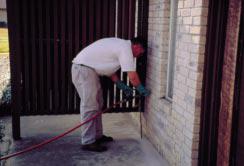
|
A
rotary hammer drill is used to drill holes for the sub-slab method of
termite treatment.
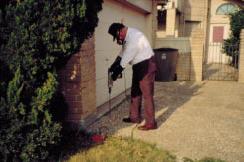
|
Alternative management
Sand
barriers
are an
alternative to chemicals. In some parts of the world, sand with
certain size particles (1/16 inch) is used to physically block termite
entry into structures. It is not approved for use in Texas. The
technology requires considerable knowledge on the part of the
applicator, and is generally unsuitable for use outdoors around the
base of a foundation unless the sand barrier can be held in place.
Fumigants
are used to
treat drywood termites, which do not need contact with the soil and
can attack dry, sound wood. To control dry-wood termites, a structure
is usually covered completely with tarps. The seams of tarps are
sealed, and a fumigant is introduced. The fumigant is maintained in
the structure long enough to eliminate the termites. The tarps are
then removed and the structure aerated before people are allowed to
return. The fumigant is very effective, but after the aeration, no
residual is left to control subsequent infestations.
Other control
methods include removing damaged wood containing the drywood colony,
or drilling and treating wood where colonies are located. These
methods can be effective, but for major infestations, fumigation is
recommended.
Heat
is
an alternative treatment approved for use in Texas on drywood termites
and wood-infesting beetles. It is not approved in Texas to treat
subterranean termites.
•
Contract for services from a reliable firm.
Choose a
termite control service with the same care and discrimination you
would use in securing any other service for your property.
Always be sure
you deal with a reliable firm that is both licensed and certified to
do the work and that has an established place of business. Here are
some ways to investigate before you invest:
•
Ask for
identification confirming that the person offering termite control is
licensed by the Texas Structural Pest Control Board. Texas has a
pesticide use and applicator law under which all commercial pest
control firms must operate. Certified applicators and technicians must
carry identification issued by the board, and service vehicles must
have Texas Pest Control License numbers permanently affixed to the
vehicle on each front fender and/or front door panel in 2-inch letters
in a color contrasting with the background color. Magnetic numbers and
letters are not considered to be permanently affixed. Contracts (and
certain other documents) must have the following stamped or printed on
them:
Licensed and Regulated by the:
Structural Pest Control Board of Texas,
1106 Clayton Lane, Suite 100LW,
Austin, TX 78723-1066,
512/451-7200
(see example
at the end of this publication)
•
If a firm
offers references of previous work, take time to check them carefully.
•
If the firm is
located in your area, make sure it has an established place of
business, which can be checked through the Chamber of Commerce or
Better Business Bureau.
•
If the firm is
from out of town, it is even more important to make sure it is
reliable. Check that it has an established place of business in the
town where it claims to be located. Most fraudulent operators work in
communities where they are not known. Ask for references and check
them careful-ly. Reliable firms welcome this approach.
•
Beware of firms that:
•
Quote a price
based only on the number of gallons of material used.
•
Profess to
have a secret formula or ingredient for termite control (all
termiticides must be registered by the Environmental Protection
Agency).
•
Have no listed
telephone number.
•
Show up
unexpectedly and use evidence of termites in trees or other nearby
houses as an excuse to inspect the house.
•
Also want to
trim trees and do general foundation repair work as part of the
“deal.”
•
Cater to
elderly or infirm people who live alone (relatives and neighbors
should warn elderly people to beware of people who knock at the door
and propose to do service work, including treating the house for
termites).
•
Claim to be
endorsed by Texas A&M University or any other state agency.
•
Claim to have
excess chemical left over from another job and offer a reduced price
if they can do the treatment immediately. Texas requires a three-day
“cooling off” period to protect consumers in any home solicitation.
•
Know the Structural Pest Control Board requirements for inspections
and treatments.
Inspections
conducted to establish the need for treatment may be made using the
company’s form; however, inspections made for a real estate
transaction must be reported on the “Texas Official Wood Destroying
Insect Report” form, SPCB/T-3. With the latter type of inspection, a
durable sign must be posted at or near the water heater closet,
electric breaker box, under the kitchen sink, or the interior of the
bath trap access. This sign must give the date of inspection
Fumigation is used to treat drywood termites.
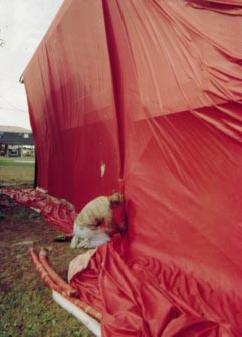
|
and name and
address of the licensee who conducted it. Before conducting a
termite treatment, the pest control company proposing the treatment
must present you with disclosure documents containing at least the
following:
•
A diagram
and description of the structure or structures to be treated.
•
The name of
the termiticide(s) to be used along with a label for the
termiticides.
•
Information
on whether or not a warranty or service contract is provided.
•
Complete
details of the warranty provided, including:
•
Areas
excluded from treatment, if any.
•
Warranty
time period.
•
Renewal
option(s) and cost(s).
•
Obligations
to retreat or repair damage caused by termites within the warranty
period.
•
Conditions
that could develop as a result of the owner’s action or inaction
that could void the warranty.
•
Signature of
approval by a certified applicator representing the company offering
termite control services.
•
Find out if they are members of a pest control association.
Membership
in the Texas Pest Control Association is evidence that a firm has an
established place of business, ascribes to a code of ethics and has
access to technical literature for training and consultation. For
the association’s membership list, write to: Executive Director,
Texas Pest Control Association, 100 E. Anderson, Suite 325, Austin,
TX 78752, 512/835-2801, or to the National Pest Control Association,
8100 Oak St., Dunn Loring, VA 22027, 703/573-8330.
Some pest
control professionals are board-certified entomologists (B.C.E.)
through the Entomological Society of America, and are usually
college graduates with a degree in entomology and appropriate
academic training.
•
Know the terms of the contract.
Ask the
termite control specialist to provide a written statement of the
proposed work and a cost estimate, along with the required
disclosure documents. The specialist must give you time to consider
the estimate.
It is
customary to provide a warranty on termite control work, either on a
year-to-year basis or for a more extended period. Plan to extend the
warranty for at least the first 2 or 3 years after the treatment is
made. Make sure you know exactly what warranty the firm offers. When
choosing a company, compare the warranties carefully. A warranty is
a guarantee of service, not a guarantee of the termite barrier. Most
companies do not offer a damage repair warranty; some companies do
offer it on any new or subsequent infestation and damage.
Read the
warranty carefully. Do not accept guarantees that vaguely refer to
termite control. Determine whether a yearly charge will be levied
during the warranty period, or whether these charges are included in
the initial price. Find out how much it will cost to extend the
warranty for additional years and ask how long it can be extended.
Make sure you get copies of the contract and warranty for your
records.
Remember
that a warranty is no better than the person or firm who gives it to
you. A warranty should not be the only evidence you consider to
determine that a firm is reliable. Many fraudulent operators use a
showy contract and warranty as part of their sales promotion.
You will
probably be asked to sign a work order or contract when you hire a
firm for termite work. Understand clearly what obligations you are
assuming and what you will get in return. As required by law, the
name, address, and telephone number of the Structural Pest Control
Board of Texas must appear on the face of each contract, warranty or
guarantee issued by the pest control operator.
When the
termite treatment is completed, the company must leave a durable
sign at or near the water heater closet, electric breaker box or
beneath the kitchen sink. The sign contains the name and address of
the company, the date of the treatment and a statement that the
notice must remain in place.
•
Most firms are reliable, legitimate businesses respected in their
communities.
Fraudulent
operators, on the other hand, aim only to swindle people out of
their money. Web sites that may be helpful to you are listed at
the end of this publication.
If you
believe that you have been the subject of fraudulent business
practices, contact the Structural Pest Control Board of Texas or
the Office of the Texas Attorney General - Consumer Protection
Division at (512) 463-2185 or (800) 621-0508. There are no charges
to the consumer to receive help from these state agencies.
(512)454-7336
Order an free estimate online.
Click here
Of course, ALWAYS READ AND FOLLOW LABEL DIRECTIONS FOR SAFE
USE OF ANY PESTICIDE!
Thank you to
Roger E. Gold, Michael E. Merchant and Grady J. Glenn
Professor and Extension Specialist in Urban Entomology;
Assistant Professor and Extension Urban Entomologist; Research Assistant,
Center for Urban And Structural Entomology for providing the publication
above.








